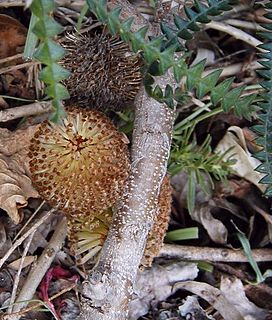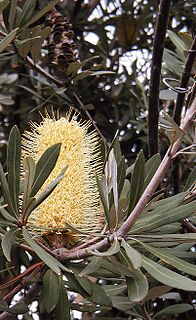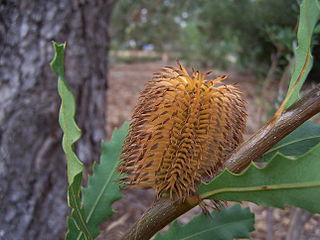
Banksia petiolaris is a rare species of flowering plant in the family Proteaceae native to Western Australia, where it is found in sandy soils in the south coastal regions from Munglinup east to Israelite Bay. It was first described by Victorian state botanist Ferdinand von Mueller in 1864, and no subspecies are recognised. B. petiolaris is one of several closely related species that will all grow as prostrate shrubs, with horizontal stems and thick, leathery upright leaves. Those of this species can be viable for up to 13 years—the longest-lived of any flowering plant recorded. It bears yellow cylindrical flower spikes, known as inflorescences, up to 16 cm high in spring. As the spikes age, they turn grey and develop up to 20 woody seed pods, known as follicles, each.

Banksia aculeata, commonly known as prickly banksia, is a species of plant of the family Proteaceae native to the Stirling Range in the southwest of Western Australia. A shrub up to 2 m (7 ft) tall, it has dense foliage and leaves with very prickly serrated margins. Its unusual pinkish, pendent (hanging) flower spikes, known as inflorescences, are generally hidden in the foliage and appear during the early summer. Although it was collected by the naturalist James Drummond in the 1840s, Banksia aculeata was not formally described until 1981, by Alex George in his monograph of the genus.

Banksia elderiana, commonly known as the swordfish banksia, is a species of shrub in the plant genus Banksia. It is a tangled, bushy shrub with stiff, serrated leaves and spikes of yellow flowers. It occurs in two disjunct areas in the Goldfields-Esperance region of Western Australia. One population extends over a large area from west of Kalgoorlie south to Ravensthorpe, with another population in the Great Victoria Desert north of the Queen Victoria Spring.

Banksia lindleyana, commonly known as the porcupine banksia, is a species of woody shrub in the genus Banksia of the family Proteaceae. It generally grows as a small shrub to 1 m (3 ft) high with long narrow serrated leaves, and bright yellow oval or round inflorescences. Flowering occurs in late summer, after which time the flower spikes age and turn to brown and then grey, and develop up to 70 follicles. It occurs in the vicinity of Kalbarri, Western Australia. Found on sandy soils, the plant serves as a pollinator for a variety of bird and animal species.

Banksia repens, the creeping banksia, is a species of shrub in the plant genus Banksia. It occurs on the south coast of Western Australia from D'Entrecasteaux National Park in the west to Mount Ragged in the east.

Banksia blechnifolia is a species of flowering plant in the genus Banksia found in Western Australia. It was first described by Victorian state botanist Ferdinand von Mueller in 1864, and no subspecies are recognised. It gained its specific name as its leaves are reminiscent of a fern (Blechnum). B. blechnifolia is one of several closely related species that grow as prostrate shrubs, with horizontal stems and leathery, upright leaves. The red-brown flower spikes, known as inflorescences, are up to 20 centimetres (8 in) high and appear from September to November in the Australian spring. As the spikes age, each turns grey and develops as many as 25 woody seed pods, known as follicles.

Banksia ser. Dryandroideae is a taxonomic series in the plant genus Banksia. First published by Carl Meissner in 1856, the name has had two circumscriptions. As presently circumscribed it is monotypic, containing only B. dryandroides.

Banksia sect. Oncostylis is one of four sections of subgenus Banksia subg. Banksia. It contains those Banksia species with hooked pistils. All of the species in Oncostylis also exhibit a top-down sequence of flower anthesis, except for Banksia nutans which is bottom-up.

Banksia sect. Banksia is one of four sections of Banksia subgenus Banksia. It contains those species of subgenus Banksia with straight or sometimes curved but not hooked styles. These species all have cylindrical inflorescences and usually exhibit a bottom-up sequence of flower anthesis. It is a widely distributed section, with taxa occurring in both the south west and east coastal distributions of the genus.

Banksia ser. Abietinae is a valid botanic name for a series of Banksia. First published by Carl Meissner in 1856, the name has had three circumscriptions.

Banksia ser. Salicinae is a valid botanic name for a series of Banksia. First published by Carl Meissner in 1856, the name has had three circumscriptions.

Banksia ser. Quercinae is a valid botanic name for a series of Banksia. First published by Carl Meissner in 1856, the name has had three circumscriptions.

Banksia ser. Tetragonae is a taxonomic series in the genus Banksia. It consists of three closely related species of erect shrub with pendulous inflorescences in section Banksia. These are:

Banksia ser. Cyrtostylis is a taxonomic series within the plant genus Banksia. First published at sectional rank by George Bentham in 1870, it was demoted to a series by Alex George in 1981. The name has had three circumscriptions.

Banksia ser. Crocinae is a taxonomic series in the genus Banksia. The series was first published by Alex George in 1981, but discarded by Kevin Thiele and Pauline Ladiges in 1996, and finally reinstated by George in 1999. Recent cladistic analyses suggest that it is monophyletic or nearly so.

Banksia ser. Banksia is a valid botanic name for a series of Banksia. As an autonym, it necessarily contains the type species of Banksia, B. serrata. Within this constraint, however, there have been various circumscriptions.

Banksia ser. Grandes is a taxonomic series in the genus Banksia. It consists of two closely related species in section Banksia, both endemic to Western Australia. These are B. grandis and B. solandri.

Alex George's taxonomic arrangement of Banksia was the first modern-day arrangement for that genus. First published in 1981 in the classic monograph The genus Banksia L.f. (Proteaceae), it superseded the arrangement of George Bentham, which had stood for over a hundred years. It was overturned in 1996 by Kevin Thiele and Pauline Ladiges, but restored by George in 1999. A recent publication by Austin Mast and Kevin Thiele suggests that it will soon be overturned again.

Banksia subser. Banksia is a valid botanic name for a subseries of Banksia. It was first used by Kevin Thiele in 1996, although as an autonym it is not considered to have been published per se. It was discarded by Alex George in 1999.

Banksia subser. Cratistylis is a valid botanic name for a subseries of Banksia. It was first published by Kevin Thiele in 1996 but discarded by Alex George in 1999.























